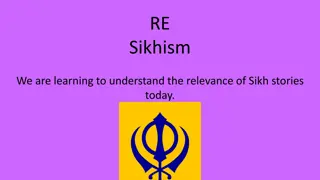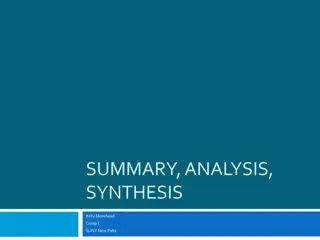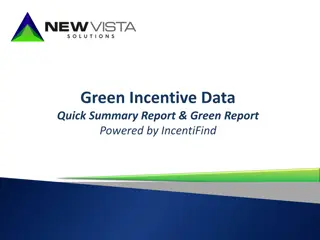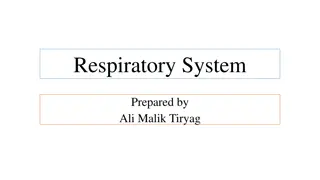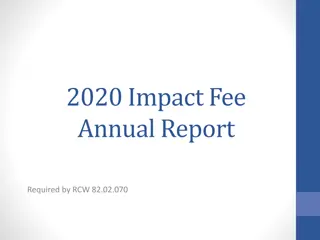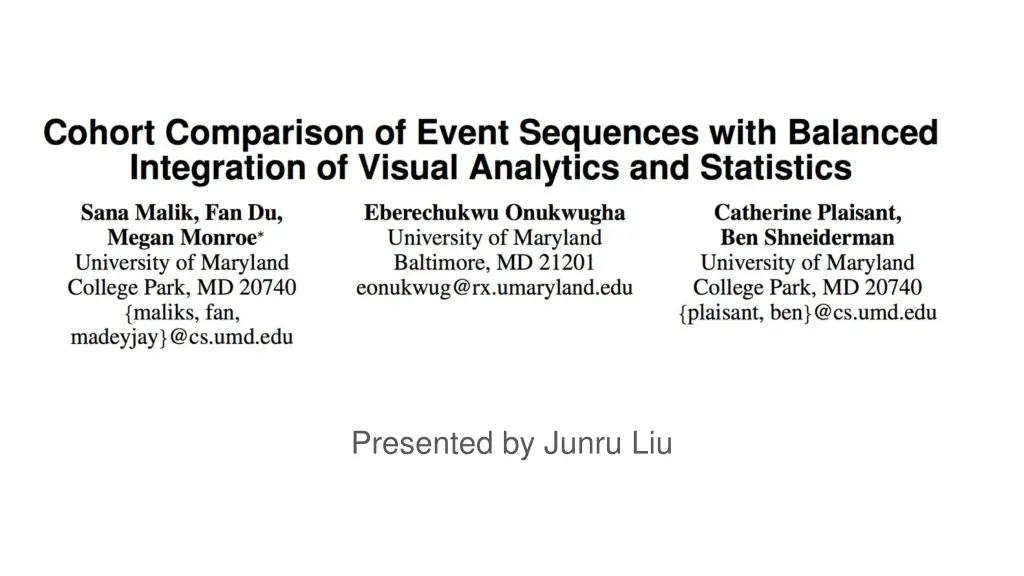
Unveiling Cohort Data Differences and Visualization Tools
Discover the nuances between datasets of an e-commerce site and electronic health records, exploring event sequences and attributes. Dive into the comparison between statistical and visual analytics tools like CoCo for cohort analysis. Learn about EventFlow, OutFlow, and MizBee in event sequence comparison.
Download Presentation

Please find below an Image/Link to download the presentation.
The content on the website is provided AS IS for your information and personal use only. It may not be sold, licensed, or shared on other websites without obtaining consent from the author. If you encounter any issues during the download, it is possible that the publisher has removed the file from their server.
You are allowed to download the files provided on this website for personal or commercial use, subject to the condition that they are used lawfully. All files are the property of their respective owners.
The content on the website is provided AS IS for your information and personal use only. It may not be sold, licensed, or shared on other websites without obtaining consent from the author.
E N D
Presentation Transcript
Background Finding the differences and similarities between two datasets (cohorts) a typical e-commerce site tracking each of its users through a series of search results and product pages until a purchase is made a database of electronic health records containing the symptoms, medications, and outcomes of each patient who is treated Common yet complex as they as differ in structure of the event sequences: event order, co-occurring events, or event frequencies attributes of events and records: patient gender metrics about the timestamps themselves: event duration Time consuming to cover all cases and tough to determine which is significant
Background Current analytics tools purely statistical or purely visual Human eyes: see context, accountability, and most notably, things that they may not have even been looking for Statistical tests: see metrics, uncertainty, and statistical significance Visualization tools strive to capitalize on human strengths The more that a visual analytics tool is designed around open-ended questions and flexible data exploration, the less it is able to effectively integrate automated, statistical analysis. Automated statistics can provide answers, but only when the questions are known Combining these two, to automatically generate concrete answers to open- ended questions. CoCo (for Cohort Comparison )
Related Work A single group EventFlow & OutFlow: Create simplified visualizations of collections of event and interval sequences Both aggregate a single cohort and the complete sequences of records EventFlow allowing users to view details about individual records as well While they only support visualizing a single group of records, comparison of multiple cohorts can be facilitated by using multiple instances of the visualization and visual inspection by the user.
Related Work Do not provide statistical information about the differences. CoCo borrows some event icon motifs from EventFlow (such as triangles for point events and T-shaped markers for interval events).
Related Work Event Sequence Comparison comparative genomics MizBee measures the similarity between genomes by visualizing the regions of shared sequences Variant View, cBio, and MuSiC only support displaying sequence variants text mining FeatureLens define an n-gram as a contiguous sequence of words and use a visualization approach to compare the co-occurrences of frequent n-grams in texts. tree comparison Temporal event sequences TreeJuxtaposer helps biologists explore structural details of phylogenetics, but focuses only on structural differences in the trees and not any attributes about the nodes (such as timestamps) TreeVersity2 compares by tree structure and the node values and is general to all trees, it leaves out temporal-specific analysis such as duration of or between interval events
Key Takeaways A taxonomy of metrics for comparing groups of temporal event sequences A visual analytics tool which demonstrates balanced integration of automated analysis and user-guided analysis with an intelligent user interface Case studies that illustrate the benefits of CoCo s utility while suggesting further refinements
Taxonomy Summary metrics Number of records, events, unique records, each event Minimum, Maximum, and Average length of records Event sequence metrics Prevalence of an event, a subsequence, a whole sequence, Outcomes Order of sequential events in a subsequence Commonly Co-occurring (non-consecutive) events Record attribute metrics population statistics such as patient gender or age
Taxonomy Time metrics Absolute time of an event Duration of interval events, a subsequence, overlap in interval events Duration between sequential events Event attribute metrics In a medical dataset, we might be interested in seeing how a particular emergency room doctor might be related to the outcome of a patient.
Cohort Comparison with Coco Design an iterative design process based on feedback from on-going case study partners and a user study G1. Automatic, efficient computation of metrics current implementation computes a metric as the user selects it. offers less guidance than if the metrics were pre-computed. future goal is to minimize wait time, but give prompt feedback on which metrics might be meaningful to look at immediately
Cohort Comparison with Coco G2. Guided process for reading results CoCo consists of a file manager pane, a dataset statistics pane, an event legend, a list of available metrics, the CoCo visualization, and options for filtering and sorting the results
Cohort Comparison with Coco G3. Visualization a back-to-back bar chart in order to emphasize the magnitude and direction of the difference, so users can more easily scan across multiple rows for results they are interested in
Cohort Comparison with Coco G3. Parsing and sorting results CoCo allows users to sort and filter the results based on their needs. Specifically, the sorting method may be changed based on: Magnitude of difference and p-value group (default) P-value only Magnitude of difference only Most differentiating towards the alpha group Most differentiating towards the beta group
Case Study: Exploring Adherence to Advanced Trauma Life Support Protocol Assessed CoCo s utility as a tool for comparing trauma care cohorts in adherence to the Advanced Trauma Life Support (ATLS) protocol. Researchers at Children s National Medical Center examined 181 patient records, exploring factors like injury severity, treatment timing, and protocol deviations. Key findings included less adherence to airway checks and greater sequence variation at night, potentially due to staffing differences. The study demonstrated CoCo s value in hypothesis generation for trauma care, though further research is needed to confirm its effectiveness.
On-going Case Study: Comparing Algorithms for Distinguishing Types of Radiation to the Bone Researchers from the University of Maryland are using CoCo to test algorithms that distinguish bone-targeted radiation from prostate radiation in claims data. While the team found CoCo valuable for visual comparisons, they suggested improvements in metric labeling. This study also prompted new CoCo features and expanded its use to other fields, such as transportation analysis.
Conclusion & Future Work CoCo is a novel visual analytics tool with balanced integration of visual analytics and statistics. Limitations of the complexity of datasets, current emphasis on two cohorts, and the need for more user control on which events to study Fresh possibilities for statistical comparisons, supported by visual presentations and an intelligent user interface, opens many doors for further research



